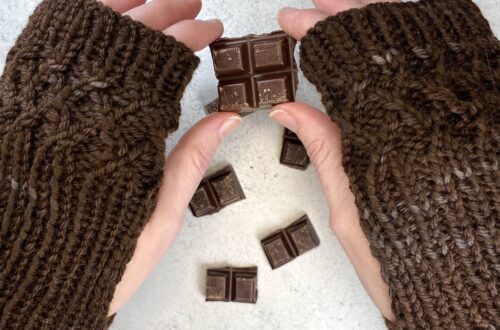How to Create an Eco-Fur Pom-Pom – (QUOE TIPS)
 As a fashion lover, I have found myself in an interesting dilemma on occasion. I love the look and feel of fur.
As a fashion lover, I have found myself in an interesting dilemma on occasion. I love the look and feel of fur.
There is just something about that luxurious fabric that makes me want to incorporate it in all my garments and accessories. I choose not to buy the real stuff, so the only alternative thus far is ‘Faux’ fur (Acrylic fibers). I’ve used it in the past, and have some hiding in my fabric stash, but it’s not the greatest thing for the environment either, and I have been trying to phase it out of my crafting. What’s that saying, again? Necessity is the mother of what?
Allow me to introduce what I call “Eco-Fur” 100% fur, 100% guilt, and cruelty free. This technique can be utilized for a lot more than pom-poms. In fact, Be sure to check out my personal blog tomorrow for a tres chic Epaulette pattern! Using the instructions laid out over this tutorial, you can add Eco-Fur to ANY fiber arts project; knit, crochet, weaving, felting, the limits are endless!
Now let’s get to making a pom-pom!
Supplies:
- Patchwork Scissors (Mini) – Art. No 493/CW
- Amour Hook Size G – Art. No 1045/G
- Sashiko Needles (Long) – Art. No 2009
- Assorted Mohair or Teeswater Locks (Ethically Sourced)
- Worsted Weight Yarn

Instructions:
Before beginning the process of creating the Eco-Fur, you must first make the base fabric. Keep in mind that this fabric may be made using knit, felt, or woven fabric as well! I will be going over a pattern for crochet.
Base Fabric:
Ch 3, sl st to 1st ch to form ring, ch 1, turn.
Round 1: Hdc 6 into ring, sl st to first st to join. -(6 hdc)
Round 2: Ch 1, [hdc 2 into next st] six times, sl st to first st from beginning to join. -(12 hdc)
Round 3: Ch 1, [hdc 1, hdc 2 into next st] six times, sl st to first st from beginning to join. -(18 hdc)
Round 4: Ch 1, [hdc 2, hdc 2 into next st] six times, sl st to first st from beginning to join. -(24 hdc) Round 5: Ch 1, [hdc 3, hdc 2 into next st] six times, sl st to first st from beginning to join. -(30 hdc)
Round 6: Ch 1, [hdc 4, hdc 2 into next st] six times, sl st to first st from beginning to join. -(36 hdc) Round 7: Ch 1, [hdc 5, hdc 2 into next st] six times, sl st to first st from beginning to join. -(42 hdc)
Fasten off leaving 6” tail.


Now you can begin to prepare your Mohair or Teeswater fibers. Try both out, you may discover you prefer one over the other. In general, Teeswater will have a longer staple length, and produce a longer fur. Take the densely packed locks, and gently begin separating out the fibers. Be careful to keep all of the fibers facing the same direction, as opposed to jumbled like felting. Once all fibers have been fulled, separate a small section (about half a centimeter wide) to begin creating the fur.

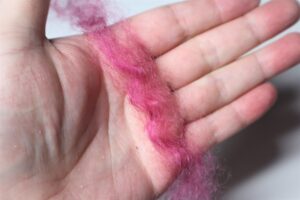
Fold fiber segment in half evenly. Take crochet hook and pass it through the first stitch created on the base fabric. Latch the crochet hook onto the midpoint of the fiber and pull through base fabric.
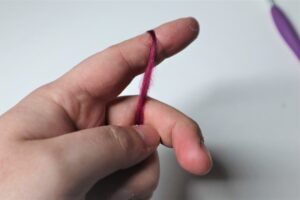
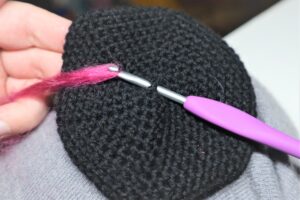
After the midpoint of fiber is pulled through the base fabric, take the crochet hook with midpoint still attached and hook the ends of the fiber, pulling through the midpoint to secure the strands to the fabric. Lightly tug after securing to lock in place. Work from the middle of the base fabric out, adding fiber locks around every stitch for the first row.


Once the first row is worked, you may begin to spread out sections. After combing and cutting the Eco-Fur, any gaps that may have shown the base fabric will be concealed. continue latch hooking fibers around the base fabric.

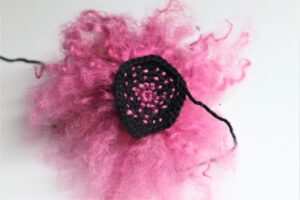
When you are satisfied that your fur is full enough, lightly comb out the fur with a regular hair comb. There will be shedding, this is expected. Save the excess fiber for a felting project, or to stuff the pom-pom! After combing through the fibers, take your scissors and trim to your desired length.


Taking your Sashiko (or darning) needle and the 6” strand of yarn from the end of the base fabric, run a line of stitches around the base fabric and pull tight to secure and form a sphere. You may add stuffing, and weave in ends.


To finish, add your pom-pom to whatever project your heart desires! Here I have whipstitched the pom-pom onto a beret with corresponding waste yarn.


If you follow along and create your own stunning pom-pom, be sure to tag Clover and me on Instagram to show us your beautiful work! For those of you who are fans of QUOE TIPS, be sure you keep an eye on the blog this time next week, as I’ll be coming at you with a brand new crochet project with hemp rope and cotton, just in time for the summer!
Until next time, break the status.

Follow what Quayln is up to next on his Blog | Instagram | Facebook | Pinterest | YouTube | Ravelry
Stay connected with Clover on Facebook | Twitter | Instagram | Pinterest | YouTube | Ravelry

